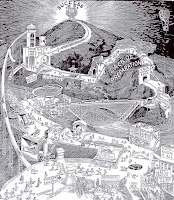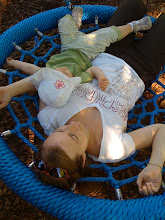Let me write down just the punchline of our saga to get G into asilo nido, and since I tell stories more and more like my mother, this will probably take several hundred words, so less punchline-y and more, well, by the time you’re done you’ll be thankful I’m only including two attempts and not all five.
Episodes #3 and #4 in the Asilo Nido Saga are all about residency: to be a part of an Italian community, you must be a resident. As I was researching our move to Italy, I saw the idea of residency come up a lot in online forums, but I thought it was retired hippy expat speak for “I didn’t truly understand Italy until I moved here.”
Nope, turns out it’s a legal term.
Italy is split into regions and the regional governments provide services that apply only to their residents. We wanted to enroll G in an asilo nido comunale: a community nursery. For residents only.
This idea of resident-only facilities or perks exists in the U.S. as well -- though I won’t digress into discussions of Arizona, which would like to kick non-legal residents out, or Alaska, which pays its residents to live there. In most American cities, to apply for a library card, one must prove residency by bringing a utility bill in one’s name that is also in the correct zip code for that library. My husband loved having a San Francisco library card, and if you’ve ever been in that library you know why. My sister lived in the city of Los Gatos, California but was once denied a library card because the Los Gatos Public Library is part of the Village of Los Gatos, and her street did not apply.
Having a utility bill won’t cut it for Italian residency. To be a resident, one must go to the local anagrafe office, show ID, fill out forms, sign documents and thereby request to be listed in public records as a resident. A police officer will eventually come to your address to confirm that you do, in fact, live there, but residency begins on the date you announce your residency to the anagrafe.
We made our 3rd attempt to apply to asilo nido with Jeremy’s residency paperwork in hand -- both the first paper he was given to prove he’d requested residency, and the confirmation letter that came several weeks later -- because we knew one of the child’s parents must have residency in the comune for the child to qualify. This was where we had mis-translated the Italian. The rule is not “the child must have one resident parent.” Rather, “the child must BE resident with one parent.”
G was not a resident. Neither was I. Back in March we were told by our local anagrafe that only Jeremy qualified for residency because only Jeremy had his permesso di soggiorno. Miss G and I had applied but not yet received them.
So when we went to apply for asilo nido, we were told that they were very sorry but since G was not listed on Jeremy’s residency form, SHE was not a resident of Trentino, and therefore she did not qualify for the public nursery system. So sorry. If only she could become a resident by tomorrow at noon, this year’s deadline to apply.
As it turns out...she could. I had checked the questura website just that morning and yes, my permesso di soggiorno and Miss G’s were available for immediate pick-up. And here’s where the insanity of Italian office hours worked, for once, in our favor. We were at the Servizi all’Infanzia office at noon on Thursday, April 29th. Most offices are open from 8:00 or 9:00 until noon, but one day each week each office is open for the afternoon as well. The Questura di Trento has Thursday afternoon office hours. We went home, ate lunch (they’re closed for lunch), took a 15:00 bus to the questura and by 16:00 were back home with shiny new permessi for G and myself.
Wait, wait, you say? What about the anagrafe office? Well, indeed, their afternoon hours are on Wednesdays, so we had to wait until the next day to visit them. Povo has its own anagrafe office for this small section of Trentino, and they were expecting us (Servizi all’Infanzia had called the day before to confirm that G was not yet a resident). The woman at anagrafe helped me fill out the proper forms, took photocopies of our passports, glanced at our permessi and then presented us quite proudly with a printout that declared G and myself residents of Trentino as of April 30, 2010.
She pointed at the date, “Last day!” she said in excellent English (English which she had refrained from using to help me fill out the forms).
It was now 9:00. We caught another bus to downtown Trento for our fourth (but not last, but that’s another story) trip to Servizi all’Infanzia. Where we successfully applied for full-time asilo nido. A mother at an adjacent desk was furiously trying to argue her way onto the list as well, but the manager told her adamantly that she was not a resident and services are for residents only. I think the manager caught my eye.
Saturday, May 29, 2010
Thursday, May 13, 2010
Toilet Training
 Our plumbing is on the fritz and the landlord blames us.
Our plumbing is on the fritz and the landlord blames us.He brought over a roll of paper towels as a prop to explain "don't use this kind of paper in the toilet." Well, I may be new to Italy, and I may not understand European plumbing -- ahem...bidets are for what exactly? -- but I know the difference between toilet paper and kitchen paper, thank you very much. And yeah, it sucks, but I also know not to trust tampons to the toilets. (Okay, I did, once or twice, but I was so paranoid about the possibility of clogging our pipes that I haven't done it since February.)
Since this conversation with the landlord took place in our entryway, which is adjacent to the bathroom in question, I quickly held up the roll of paper sitting next to the toilet and said, "this is what we're using!" The landlord looked quite puzzled because, yes, that's the right kind to use. He then explained that a plumber just yesterday pulled a large ball of thick paper out of the pipes. "That's strange," I said, "because this is the only toilet paper we're using."
Our landlord scratched his chin and said hmmm (really, he does this!!). "There is no one below your apartment yet. It could maybe be the apartment upstairs. It is one pipe. It is either them or you."
Now, is it possible that my husband and I use so much toilet paper when we wipe that it clogs the fragile Italian pipes despite it's uber-thinness? Sure, I suppose, but I think it's much more likely that our upstairs neighbors are the culprits. However, the upstairs neighbor explanation does not seem to have crossed our landlord's mind until today, when I showed him the clear shining proof of our Italian toilet paper.
The landlord also mentioned, as he left, that there will likely be a plumbing bill for the work. We'll see how much we get charged -- and if the neighbors upstairs are being asked to split the cost.
Monday, May 3, 2010
The Road to Asilo Nido
 A.k.a. nursery school or Italian daycare, asilo nido is available to infants aged 3 months to 3 years, at which point Italian children attend scuola materna until age 6. Scuola materna is often translated as Kindergarten, but it's more like three years of preschool. More on that if we survive Italy long enough for Miss G to reach scuola materna age.
A.k.a. nursery school or Italian daycare, asilo nido is available to infants aged 3 months to 3 years, at which point Italian children attend scuola materna until age 6. Scuola materna is often translated as Kindergarten, but it's more like three years of preschool. More on that if we survive Italy long enough for Miss G to reach scuola materna age.We decided in January or February that we wanted to enroll Miss G in asilo nido next fall. I've been asked why, if I'm not working, we would want G in daycare. One answer is that Italy is lonely, and being alone in a 68 m2 apartment with a toddler is lonely. Try doing both at once. I dare you. Another reply is that asilo nido will allow G to learn Italian and allow me to take language classes, write, find a part-time job.
Asilo nido comes in two flavors: private and public. Private daycares range from okay to excellent and are rather expensive. Public daycares are run by the individual comune; they are gorgeous early education facilities and highly subsidized. From what I can tell, most Italian parents would prefer the public nido for their children. Getting in is a tricky numbers game that balances limited availability with a family's need (need criteria include physical, mental or social disability, income level, number of children in the family, parents' work hours). As a family, J and I don't rate high on the comune's need criteria, but it would be foolish not to try to get G in.
The application is simple: bring an ISEE form (a financial statement filled out by a qualified financial services office) and proof of residency in the comune to the Servizi all'Infanzia office. Even non-Italian speakers like ourselves should be able to pull this application off. However, it took 5 trips in 4 days spread out over two weeks to get the application completed, including a last-24-hours-before-the-deadline dash to the questura (police/immigration headquarters) and our local anagrafe (Povo Technical Office -- see previous post) to gather the necessary documentation.
I don't have the energy to walk through the steps again here. One kind expat we've told the full story to was kind enough to reply, "Oh, but now she has to get in. There's no way she won't get in after all you went through to apply."
The believer in me knows, "Yes, of course she'll get in."
The exhausted immigrant in me says, "But this is Italy, and nothing works out for the best in Italy."
***
The Comune of Trento provides tantalizing bits of information to its foreign population in English and sometimes French. For more info on the public asilo nidi of Trentino, see Servizi all'infanzia: introduzione.
Subscribe to:
Posts (Atom)

